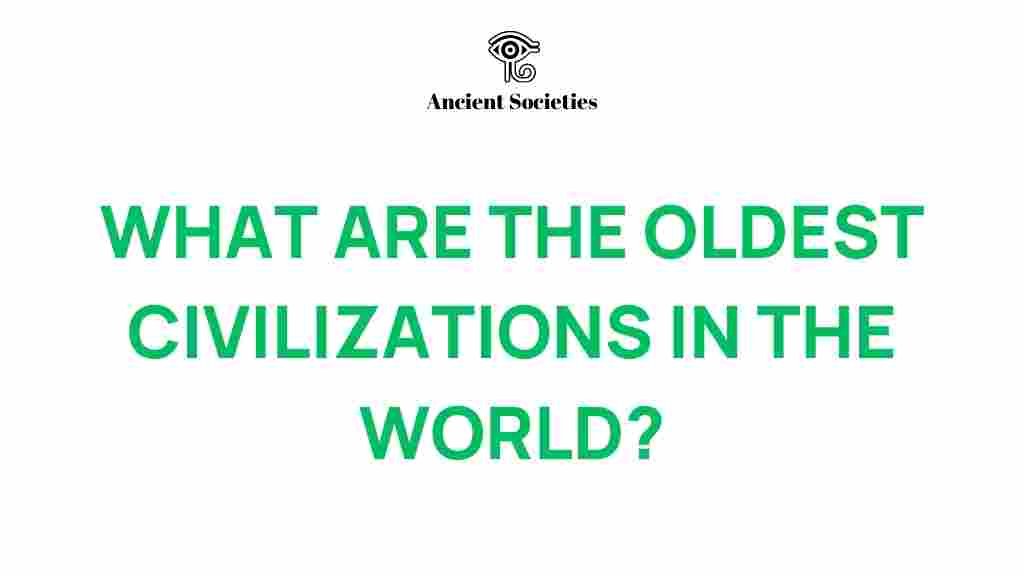Unveiling the Mysteries: What Are the World’s Oldest Civilizations?
Throughout the annals of ancient history, a select few societies have left an indelible mark on the evolution of humanity. These oldest civilizations provide invaluable insights into our cultural heritage, societal evolution, and the foundations of modern life. By examining civilizations such as Mesopotamia, Egypt, the Indus Valley, and Ancient China, we can unlock the secrets of our past and appreciate the rich tapestry of human achievement.
1. Mesopotamia: The Cradle of Civilization
Often referred to as the “Cradle of Civilization,” Mesopotamia is located in the fertile land between the Tigris and Euphrates rivers, in what is modern-day Iraq. This region is known for:
- The development of the first writing system, cuneiform.
- The establishment of city-states like Uruk and Babylon.
- Innovations in agriculture, mathematics, and astronomy.
Mesopotamia’s contributions to human development are monumental. The Sumerians, Akkadians, Babylonians, and Assyrians all played pivotal roles in shaping early societal structures and cultural practices.
2. Ancient Egypt: A Legacy of Pharaohs
Another significant player in the realm of oldest civilizations is Ancient Egypt, renowned for its remarkable achievements and rich cultural heritage. Located along the Nile River, Egypt’s civilization can be characterized by:
- Iconic structures such as the Pyramids of Giza and the Sphinx.
- The development of hieroglyphics, one of the earliest writing systems.
- A complex pantheon of gods and a deep belief in the afterlife.
The unbroken continuity of Egyptian culture for over three millennia makes it a fascinating subject of study for archaeologists and historians alike.
3. The Indus Valley Civilization: A Mystery Unraveled
Stretching across present-day Pakistan and northwest India, the Indus Valley Civilization (IVC) flourished around 2500 BCE. Despite its significance, much about this civilization remains shrouded in mystery due to the undeciphered script. Key features include:
- Advanced urban planning, evidenced by cities like Harappa and Mohenjo-Daro.
- An impressive drainage system and public baths.
- A thriving trade network with Mesopotamia and other regions.
Archaeological findings have revealed a sophisticated society, but the reasons for its decline around 1900 BCE still provoke debate among scholars.
4. Ancient China: Dynasties of Innovation
Ancient China is one of the world’s oldest continuous civilizations, with a history spanning over 5,000 years. The early dynasties, such as the Xia, Shang, and Zhou, were instrumental in the development of Chinese culture and innovations like:
- Writing systems, including oracle bone script.
- Technological advancements such as silk production and bronze casting.
- Philosophical teachings from figures like Confucius and Laozi.
Chinese civilization’s resilience and adaptability have allowed it to remain a major influence in global culture and politics.
5. The Importance of Archaeology in Understanding Oldest Civilizations
Archaeology plays a crucial role in uncovering the mysteries of the oldest civilizations. Through excavation and analysis, archaeologists can:
- Uncover artifacts that provide insight into daily life, trade, and religion.
- Reconstruct ancient societies and their interactions.
- Preserve cultural heritage for future generations.
Continued archaeological efforts are vital for expanding our understanding of how these civilizations evolved and influenced one another.
6. Societal Evolution: Lessons from the Past
Studying these ancient civilizations offers valuable lessons in societal evolution. By examining their successes and failures, we can gain insights into:
- The importance of governance and law in maintaining order.
- The role of trade and economy in cultural exchange.
- The impact of environmental changes on societal stability.
Understanding the dynamics of these early societies can inform contemporary discussions about sustainability and cultural preservation.
7. Troubleshooting Common Misconceptions
When discussing the oldest civilizations, several misconceptions often arise. Here are some common misunderstandings and clarifications:
- Misconception: Mesopotamia was the only ancient civilization.
Fact: While it is one of the earliest, other significant civilizations like Egypt, the Indus Valley, and China also emerged independently. - Misconception: All ancient civilizations were similar.
Fact: Each civilization had unique cultural practices, governance structures, and technological advancements. - Misconception: Archaeology is only about digging.
Fact: Archaeology also involves analyzing artifacts, understanding historical contexts, and interpreting data to reconstruct past societies.
Conclusion: A Tapestry of Human Achievement
The exploration of the oldest civilizations reveals a tapestry woven with threads of innovation, culture, and resilience. From the fertile plains of Mesopotamia to the monumental pyramids of Egypt, the meticulously planned cities of the Indus Valley, and the dynastic innovations of China, each civilization contributed uniquely to the human story. As we continue to delve into ancient history through archaeology, we not only preserve our cultural heritage but also gain a clearer understanding of our collective journey. To learn more about the impact of these ancient societies, visit this resource.
For those interested in further exploring ancient history, consider reading more about the influence of these civilizations on modern societies here.
This article is in the category History and created by AncientSocieties Team
